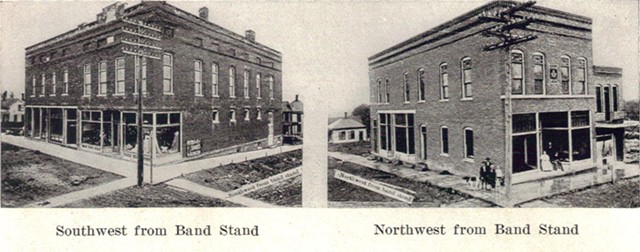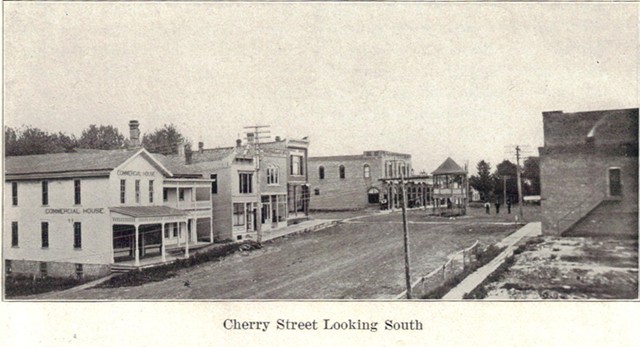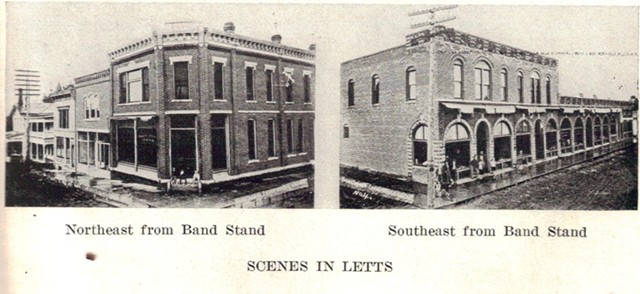
| LOUISA COUNTY, IOWA |  |

| LOUISA COUNTY, IOWA |  |
HISTORY of
LOUISA COUNTY IOWA
Volume I
BY ARTHUR SPRINGER, 1912
Submitted by Lynn McCleary, November 8, 2013
CHAPTER XVII.
VILLAGES AND TOWNS
FREDONIA. pg 296
was laid out by Alvin Clark in July, 1840, and the plat is surveyed by John Gilliland, county surveyor, under date February 12, 1846. The town was situate on the east bank of the Iowa river, immediately below the junction of the Iowa and Cedar rivers in section 20, township 75 north, range 4 west.ALIMEDA, a part of Fredonia, was laid out by James Waterbury, July 28, 1859, in the southwest corner of the northeast quarter of section 20, 75-4.
It is often said that Fredonia came near being the capital of Iowa; that it only lost it by one vote. Sometimes the number of votes lacking is given at three, etc. There is really no foundation for the story, in the way in which it is usually told. Neither Fredonia, nor any other place in this county, ever had any chance to be the capital. It is true, however, that Fredonia, Black Hawk, Wapello and many other places were proposed and voted for in the House of Representatives, while there was a contest going on between Mt. Pleasant and Iowa City, and that they only lacked from one to three votes of a majority in the House. This was in the winter of 1838-9; but there was never any serious intention of …
Photos of scenes in Letts



pg 297
... locating the capital here, and the name of Fredonia was never even voted upon in the Council.Enoch K. Maxson was the first doctor in Fredonia; he had a "grocer's license" in 1840. as did also Mrs. Lucinda Bliven, who afterward married William Todd.
In July, 1839, Marvel Wheelock was licensed to keep a tavern at Fredonia, and also to run a ferry across the Iowa river "below the forks."
Lotrip Darling, an early settler in Concord township, or rather, Fredonia township, as it was first called, was the first blacksmith in Fredonia.
The railroad reached Fredonia in 1857, and ran its first train east from there on July 4th of that year. George Haywood was the first agent.
John Bryson sold lumber there after the railroad came, then went to Columbus City, and later to Clifton. Fredonia was something of a "seaport" in the days of traffic on the Iowa river, but what little we have learned about that is to be found in the chapter on transportation.
A series of meetings were held at Fredonia in 1842 by Rev. James L. Scott, who made a missionary tour from Rhode Island to the great west that year, and published a journal which contains some interesting items about Fredonia, Hillsboro and that vicinity. Mr. Scott's journal says that he traveled from Burlington to Fredonia May 25, 1842, and gives the distance as forty-four miles. Aside from a few newly commenced settlements and an occasional grove he found the scene along the way practically the same, being "an unbounded sea of prairie." At twilight he reached the Iowa river, his patience being sorely taxed by the indolence of the lads who tended the ferryboat at Clark's ferry.
He describes Fredonia as "A small village, situated on the bank of the Iowa river, just at the junction of the Iowa and north fork of the Cedar rivers. I have often thought while here that'they had as commodious a location for a large town as I ever saw in the interior of a country." He noted the fine timber all around, which seemed to him to be much taller than that in Illinois, and noted also that they were then erecting a steam sawmill opposite Fredonia.
Referring to Hillsboro, which is better known now by the name of Toddtown he says: "Hillsboro is conveniently located for a harbor and town, and had already begun to erect its edifices. It lies on the opposite side of the river from Fredonia, and about one mile above on the Iowa branch. Through it a territorial road passes from Burlington to Iowa City. Here Captain Wheelock keeps a commodious ferryboat." He also refers to several "neat buildings" that had just been commenced.
He has this to say of Columbus City, although he gets the name slightly wrong. "About three miles back on the route to Burlington is Columbia City, a small village, but I cannot now see what will keep it alive, as it is situated on a dry prairie. It has, however, a very pleasant location."
In the latter part of May, Rev. Scott began a series of meetings at Fredonia. Of the first one he says: "At eleven o'clock the people began to flock to Fredonia and we listened to a discourse from a Methodist brother. At two p.m. I addressed the congregation and commenced a series of meetings which were kept up as much as consistent until my health completely failed, and I was obliged to leave a weeping and anxious people. . . . Four o'clock p. m. I addressed a congregation of anxious hearers. Many came from distance. Had a meeting again in. the evening. Sinners began to inquire the way to heaven."
pg 298
Under date of May 27th is the following report in his journal: "Took a circuitous route back of Fredonia (probably east) through the prairies, interspersed with groves. We traveled on a ridge of land which led us through one plantation where was about 800 acres under cultivation. On either side of the road were large fields of wheat, corn, oats and potatoes. . . . We kept the ridge for some distance and were able to survey much of the surrounding country, which for picturesque scenery and agricultural conveniences surpasses everything I ever saw before, or expect to see again."
On the 28th, which was Sabbath, the reverend gentleman held services and then went to Osceola, or Hillsboro, and spent the night. On the next day he passed down the river from Hillsboro to Fredonia in a canoe in company with Captain Wheelock and lady. On this day the people gathered from far and near and the good man was almost persuaded to settle down in Fredonia.
From that time Sabbath meetings continued until the 8th of June, when he was obliged by ill health to close in the middle of a sermon. He was pained at heart to leave this field and expressed the fervent wish that "Zion did but know the deep wretchedness and anxieties of many of the people scattered through the great western valley," and the belief that, if so, they would "fly to their relief and help exterminate the heresies, infidelity, popery and Mormonism."
One of the most interesting things in Mr. Scott's little book is what he says about Osceola. This is the name given by Mr. Scott to the high hill or bluff at Toddtown on the bank of the Iowa river, just west of the Rock Island track He says: "West of the territorial road at Hillsboro is the rising bank of Osceola, or the mound upon which the Indians came to trade, as this was the converging point of the nations general resort. We ascended to its conical head. This is about 100 feet above the river, which flows directly beneath, and about one mile from Fredonia. ... A prospect from the summit must present a still more tempting scene than that from the towering mound which overhung the beloved city in the eastern world. Just before us between the two rivers was Port Island."
He, of course, meant Port Allen. Farther on he says: "Northwest of us we saw a tree which from its distance resembled an umbrella. I was informed that it was a large oak eighteen miles distant and stood on the great territorial road which leads from Burlington to Iowa City. About two miles south of us was Columbus City. Thus in every direction we could survey the 'garden of the west.'
"I thought while standing there that this mound might yet sustain an academy, and from it the student might survey the geographic features of both river and sky."
Further on he says of this general locality: "The Iowa river is one of the largest tributaries of the Mississippi, affording steamboat navigation the principal part of the year to Fredonia and Hillsboro. From thence to Iowa City it is susceptible of keelboat navigation. With this view of the subject it is readily inferred that the towns at the confluence of the Iowa and Cedar rivers will eventually take the lead in commerce, notwithstanding the capital is above them in point of location, and its population far superior." Concerning the wild fruits and wild animals in the Iowa country he says: "Wild plums almost of unnumbered varieties grow in profusion, and the deep recesses of the forests abound ...
pg 299
... in wild grapes," etc. He mentions also crab apples and various kinds of berries, and foxes, raccoons, opossum, gophers, porcupines, squirrels, otter and deer, and says that the rivers, lakes and creeks abound in speckled trout, white perch, black and rock bass, catfish, shad, eels, sturgeon and buffalo.He describes with much feeling his departure from Fredonia and the "bursts of sorrow" with which the people received the intelligence that he was about to leave them. In conclusion he says that a church was constituted and founded in Fredonia in which Dr. Enoch Maxson was clerk. He refers to Fredonia as a very convenient location for a large town, being on the bank of the Iowa river "up and down which the proud steamer frequently plays, laden with almost everything necessary for domestic use in this newly settled country."
As noted elsewhere, when the townships were first established, what is now Concord was a part of Fredonia township, which embraced all, or practically all, of the present townships of Oakland and Concord. In those days Fredonia was a place of considerable importance. It was incorporated in 1874, the vote on the question being taken on May 30th, and resulting 23 for incorporation and hone against. The population is given as follows: 1870—150; 1875— 123; 1880—157: the population of Fredonia seems to have been included with that of the township, and not given separately, in the subsequent enumerations. Cram's Atlas for 1911 gives the population for 1910 at 250, but this may be only an estimate.